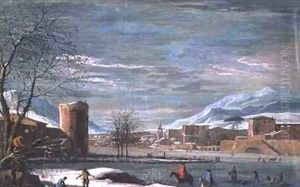(attr.) Filippi, Paolo de Paintings
Paolo de Filippi, commonly referred to as Paolo da San Leocadio or Paolo di Dono, was an Italian Renaissance painter whose work is associated with the school of Leonardo da Vinci. Born in 1460 in San Leocadio, which is now part of modern Italy, Paolo de Filippi is not as widely known as his more famous contemporaries, and his biography is somewhat obscure due to the lack of extensive documentation.
Little is known about his early life and training, but it is believed that he may have been influenced by the work of Leonardo da Vinci, as his style exhibits a similar attention to detail and mastery of chiaroscuro. Paolo de Filippi's work is characterized by its delicate handling of light and shadow, a hallmark of the High Renaissance style, and his figures often exhibit a serene, introspective quality.
Despite the scarcity of information, some of Paolo de Filippi's works have been identified, including religious paintings and frescoes. However, his oeuvre is small, and many pieces attributed to him might actually be the work of his contemporaries or followers, as was common in the Renaissance when workshops often produced paintings in the style of their masters.
Paolo de Filippi's career unfolded during a time of great artistic innovation in Italy, and though he may not have achieved the fame of Leonardo, Michelangelo, or Raphael, his contributions to the period's artistic developments were notable. He passed away in 1504, leaving behind a modest but meaningful legacy within the tapestry of Italian Renaissance art. As with many artists of the era, his works may still be awaiting rediscovery and proper attribution, which could shed further light on his artistic journey and impact.
